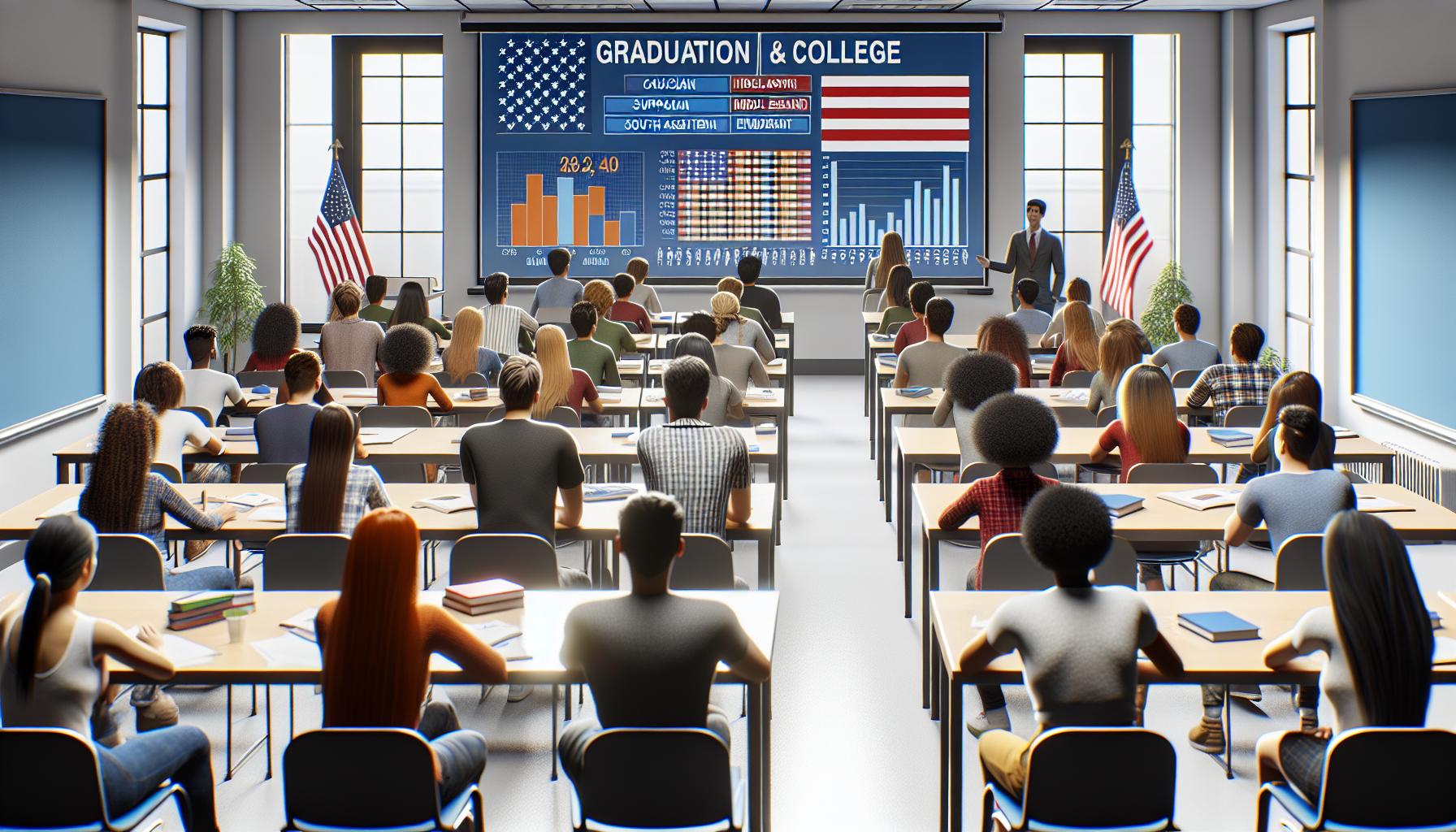Education is a cornerstone of personal and societal growth, shaping the future of individuals and communities. Understanding education rates by state reveals significant disparities that influence opportunities and outcomes across the nation. From high-performing states with robust educational systems to those struggling to keep pace, these statistics offer valuable insights into how education impacts economic stability and social mobility.
By examining these rates, one can uncover trends and factors that contribute to success or challenges in various regions. Whether it’s access to resources, funding disparities, or policy decisions, the landscape of education is complex and ever-evolving. This exploration not only highlights the importance of education but also emphasizes the need for informed discussions about how to improve educational outcomes for all students.
Key Takeaways
- Education Disparities: There are significant disparities in education rates across the United States, impacting student achievement and future opportunities.
- Key States: Virginia, Massachusetts, and New Jersey exhibit the highest graduation and college enrollment rates, highlighting effective educational policies and funding.
- Influencing Factors: Economic stability, demographic variations, teacher quality, and policy decisions play crucial roles in shaping education rates by state.
- Economic Impact: Higher education rates correlate with improved economic outcomes, lower unemployment, and enhanced community well-being.
- Social Mobility: Education levels directly influence social mobility, with higher graduation rates fostering greater opportunities for residents.
- Public Health and Crime: States with strong educational systems often see better public health outcomes and reduced crime rates, underscoring the societal importance of education.
Education Rates By State
Education rates vary significantly across the United States, impacting student achievement and future opportunities. This section examines key data on educational attainment, including high school graduation rates and college enrollment figures, providing a clearer picture of state-by-state disparities.
Key Statistics
| State | High School Graduation Rate (%) | College Enrollment Rate (%) |
|---|---|---|
| Massachusetts | 90.6 | 69.9 |
| New Jersey | 90.0 | 67.1 |
| Virginia | 88.5 | 65.4 |
| Texas | 90.0 | 59.2 |
| California | 83.9 | 55.7 |
| Mississippi | 87.0 | 53.2 |
Virginia leads in high school graduation rates, closely followed by New Jersey and Massachusetts. In contrast, California reflects lower graduation, which correlates with its college enrollment figures. Texas, showcasing a solid graduation rate, has a comparatively lower college progression percentage, emphasizing the need for enhanced support post-graduation.
Factors Influencing Education Rates
Education rates are influenced by several factors:
- Funding Levels: States that allocate higher funding to education often show better outcomes.
- Teacher Quality: Access to experienced educators significantly impacts student success.
- Economic Stability: States with stronger economies typically have better educational infrastructure.
- Policy Decisions: Legislation directly affects resource allocation and educational reforms.
Understanding these elements helps in identifying areas for improvement, aiming to enhance educational outcomes across the United States.
Factors Influencing Education Rates

Education rates vary significantly across states due to several interconnected factors. Understanding these influences provides insight into the disparities in educational outcomes.
Economic Status
Economic status strongly impacts education rates. States with higher median household incomes typically allocate more funding to educational systems, resulting in better resources, facilities, and teacher salaries. For example, Massachusetts, known for its economic stability, reports some of the highest graduation rates. Conversely, states facing economic challenges, like Mississippi, often struggle with lower funding, leading to inadequate educational opportunities and lower student performance outcomes.
Population Demographics
Population demographics influence education rates through factors like racial and ethnic diversity, age distribution, and urban versus rural populations. States with larger minority populations may face unique challenges related to access and equity, especially in education. For instance, New York, with its diverse population, invests significantly in educational programs aimed at addressing the needs of various demographic groups. Additionally, urban areas often experience higher dropout rates due to socioeconomic disadvantages, while rural areas may struggle with access to quality education due to geographical isolation and limited resources.
Comparison of Education Rates By State

Education rates vary significantly by state, impacting opportunities and societal outcomes. This section outlines high school graduation and college enrollment rates across the United States.
High School Graduation Rates
High school graduation rates demonstrate discrepancies among states, reflecting students’ access to quality education. States like Virginia maintain graduation rates around 92%, benefiting from robust funding and effective educational policies. Conversely, states such as Mississippi report rates near 80%, influenced by limited resources and socioeconomic challenges. Improved investment in teacher training and student support has shown to elevate graduation rates. Below are recent statistics highlighting these disparities:
| State | Graduation Rate (%) |
|---|---|
| Virginia | 92 |
| Massachusetts | 90 |
| New York | 87 |
| Mississippi | 80 |
| California | 78 |
| State | College Enrollment Rate (%) |
|---|---|
| Massachusetts | 70 |
| Virginia | 68 |
| New York | 65 |
| California | 60 |
| Mississippi | 45 |
State-Specific Insights

Education rates vary significantly across states, reflecting differences in funding, demographics, and policy decisions. Analyzing these state-specific insights provides a clearer picture of educational success and challenges.
States with the Highest Education Rates
States with the highest education rates demonstrate effective resource allocation and robust educational policies.
- Virginia: High school graduation rate at 92%, with college enrollment at approximately 68%. Consistent investment in educational resources and a strong focus on teacher quality contribute to their success.
- Massachusetts: High school graduation rate of 90% and college enrollment near 72%. The state’s strong economy allows for higher per-student spending, translating into better educational outcomes.
- New Jersey: Graduation rate of 91% and college enrollment at about 69%. Innovative programs and high funding levels support diverse student populations.
These states exemplify how strategic investment and policy can lead to superior educational outcomes.
States with the Lowest Education Rates
Several states face challenges that result in lower education rates, impacting economic stability and social mobility.
- Mississippi: Reports a graduation rate of 80% and a college enrollment rate of 45%. Limited funding and high levels of poverty hinder educational improvement.
- California: Experiences a graduation rate of around 78%, with college enrollment at 60%. Though it has a large population, disparities in resources and socioeconomic challenges affect educational performance.
- Alabama: High school graduation rate of 81% and college enrollment at 47%. Economic difficulties and resource allocation issues contribute to these lower figures.
These states highlight the critical importance of addressing funding disparities and socioeconomic factors to enhance educational success.
Impact of Education Rates on Society
Education rates significantly influence various societal aspects, including economic growth, crime reduction, and overall community well-being. Higher education rates correlate with increased earning potential, as individuals with higher education levels tend to secure better-paying jobs. For instance, states with graduation rates exceeding 90% often experience lower unemployment rates, enhancing local economies.
Education rates also affect social mobility. In states like Massachusetts, where high school graduation rates reach 90%, residents enjoy greater opportunities for upward mobility compared to areas with lower rates. Such disparities create a cycle where low education rates contribute to poverty and limited career options.
Moreover, education rates impact public health. Studies indicate that individuals with higher education levels are more likely to engage in healthy behaviors and seek preventive care. States investing in education witness improvements in health outcomes, reducing healthcare costs and enhancing quality of life.
Crime rates often reflect education levels in a community. Research shows that lower education rates contribute to higher crime rates. Areas with robust educational systems typically report decreased criminal activity, emphasizing the need for effective educational policies.
Ultimately, education rates shape societal structures, directing policy initiatives and resource allocation. Enhanced educational outcomes lead to thriving communities, underscoring education’s critical role in societal progress.
Education rates by state reveal significant disparities that impact individuals and communities alike. These differences highlight the urgent need for targeted interventions and resource allocation to bridge the gaps. States that prioritize educational funding and effective policies tend to see better outcomes in graduation and college enrollment rates.
Addressing the challenges faced by underperforming states is essential for promoting social mobility and economic stability. As education continues to shape societal structures, fostering informed discussions and collaborative efforts will be crucial for enhancing educational opportunities for all students across the nation.